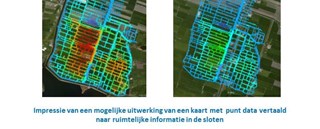Groot-Limmerpolder
Measuring at Texel
Groot-Limmerpolder embarked on an area planning process to explore the options of using water from the area itself to ensure sufficient supply of clean water. The integration of substantive knowledge with the process led to an effective decision-making process and was able to generate the support of stakeholders in the area.
The process is illustrated using a ‘double helix’. This is a visual representation of the three-pronged structure that was applied in the area. The first phase emphasized the relevance and urgency of sufficient fresh water by presenting knowledge on current and future water supplies. The relevance of the various measures was specified in greater detail during the second phase, pointing to possible solutions. In order to be able to present well-founded solutions that can be implemented in practice, this phase was supported by area-specific knowledge and data on water needs classified by utility purpose. During the third and last phase, the problem-solving approaches were specified in further detail, including the associated opportunities and risks, and reviewed for stakeholder consensus.
The process was initiated by the Hollands Noorderkwartier Higher Water Board and the North Holland Landscape Foundation (Landschap Noord-Holland). In doing so, they took the first steps towards a robust and future-resilient water management system. The complexity of the problems in combination with the many conflicting interests at play have prompted the parties involved to formulate and develop a joint approach. Engaging in dialogue helps to promote mutual understanding and to foster people’s willingness to cooperate as partners. By consequence, it is an important step towards arriving at viable solutions. This concept proved successful earlier during the development of the Delta Vision by the Hollands Noorderkwartier Higher Water Board.
 3590478_1_org
3590478_1_org